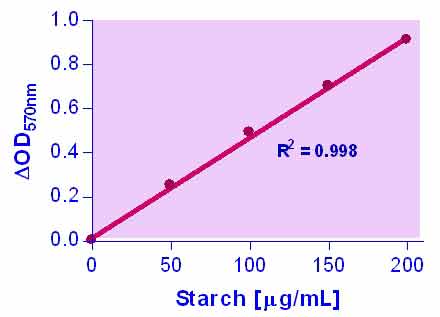EnzyChrom™ Starch Assay Kit
Application
- For quantitative determination of starch and evaluation of drug effects on starch metabolism.
Key Features
- Use as little as 10 µL samples. Linear detection range: 2 to 200 µg/mL starch for colorimetric assays and 0.2 to 20 µg/mL for fluorimetric assays.
Method
- OD570nm, or FL530/585nm
Samples
- Biological, agriculture, food, etc
Species
- All
Procedure
- 30 min
Size
- 100 tests
Detection Limit
- 2 µg/mL
Shelf Life
- 6 months
More Details
STARCH, chemical formula (C6H10O5)n, is a polysaccharide carbohydrate consisting of a large number of glucose units joined together by glycosidic bonds. All plant seeds and tubers contain starch present in the form of amylose and amylopectin. Starch is the most consumed polysaccharide in the human diet. Some starches are digested very quickly and cause a rapid and large rise in blood sugar. Others are digested more slowly, and some starch, called resistant starch, is not digested in the small intestine at all and thus causes little or no blood sugar rise. Simple, direct, and automation-ready procedures for measuring starch concentrations find wide applications in research and drug discovery. BioAssay Systems starch uses a single Working Reagent that combines the enzymatic breakdown of starch and the detection of glucose in one step. The color intensity of the reaction product at 570 nm or fluorescence intensity at λex/em = 530/585 nm is directly proportional to the starch concentration in the sample. This simple convenient assay is carried out at room temperature and takes only 30 min.What is the principle of the starch assay?
Starch is first broken down into glucose molecules by α-amylase and amyloglucosidase. Next, glucose is converted to glucuronic acid and H2O2 by the enzyme glucose oxidase. Finally, H2O2 and ADHP are converted to the pink colored product resorufin and water by horse radish peroxidase.
What is the difference between soluble and resistant starch?
Soluble starch is starch that is soluble when heated to 60°C. Resistant starch does not dissolve.
Liu, F., et al. (2020). An invasive beetle-fungus complex is maintained by fungal nutritional-compensation mediated by bacterial volatiles. The ISME Journal, 14(11), 2829-2842. Assay: Starch in phloem medium.
South, P. F., Cavanagh, A. P., Liu, H. W., & Ort, D. R. (2019). Synthetic glycolate metabolism pathways stimulate crop growth and productivity in the field. Science, 363(6422), eaat9077. Assay: Starch in plant seed.
Ort, D. R., South, P. F., & Walker, B. (2018). U.S. Patent Application No. 15/913,395. Assay: Starch in Nicotiana tabacum leaf.
Wilson, C. M. (2016). Long-term impacts of invasive herbivores on tree physiology, growth, and phenology: A whole-tree perspective. Assay: Starch in hemlock root.
Gardner RD et al (2013). Comparison of CO(2) and bicarbonate as inorganic carbon sources for triacylglycerol and starch accumulation in Chlamydomonas reinhardtii. Biotechnol Bioeng. 110(1):87-96. Assay: Starch in algae Chlamydomonas reinhardtii.
Tsuge, Y., Tateno, T., Sasaki, K., Hasunuma, T., Tanaka, T., & Kondo, A. (2013). Direct production of organic acids from starch by cell surface-engineered Corynebacterium glutamicum in anaerobic conditions. AMB Express 3(1): 72. Assay: Starch in Corynebacterium glutamicum cell culture.
Boriboonkaset T et al (2012) Expression levels of some starch metabolism related genes in flag leaf of two contrasting rice genotypes exposed to salt stress. Aust. J. Crop Sci. 6(11):1579-1586. Assay: Starch in plant rice leaf.
Boriboonkaset T et al (2012) Expression levels of some starch metabolism related genes in flag leaf of two contrasting rice genotypes exposed to salt stress. Aust. J. Crop Sci. 6(11):1579-1586. Assay: Starch in Plant Rice leaf.
Zebeli Q et al (2011) Intraruminal administration of Megasphaera elsdenii modulated rumen fermentation profile in mid-lactation dairy cows. J Dairy Res 13:1-10. Assay: Starch in plant cow feed.
Iqbal S et al (2009) Feeding barley grain steeped in lactic acid modulates rumen fermentation patterns and increases milk fat content in dairy cows. J Dairy Res 92(12):6023-32. Assay: Starch in food grain starch.
To find more recent publications, please click here.
If you or your labs do not have the equipment or scientists necessary to run this assay, BioAssay Systems can perform the service for you.
– Fast turnaround
– Quality data
– Low cost
Please email or call 1-510-782-9988 x 2 to discuss your projects.

$429.00
For bulk quote or custom reagents, please email or call 1-510-782-9988 x 1.
Orders are shipped the same day if placed by 2pm PST
Shipping: On Ice
Carrier: Fedex
Delivery: 1-2 days (US), 3-6 days (Intl)
Storage: -20°C upon receipt
Related Products
You may also like…
| Name | SKU | Price | Buy |
|---|---|---|---|
| EnzyChrom™ Glycogen Assay Kit | E2GN-100 | $449.00 | |
| QuantiChrom™ Glucose Assay Kit | DIGL-100 | $329.00 |
Why BioAssay Systems
Quality and User-friendly • Expert Technical Support • Competitive Prices • Expansive Catalogue • Trusted Globally
